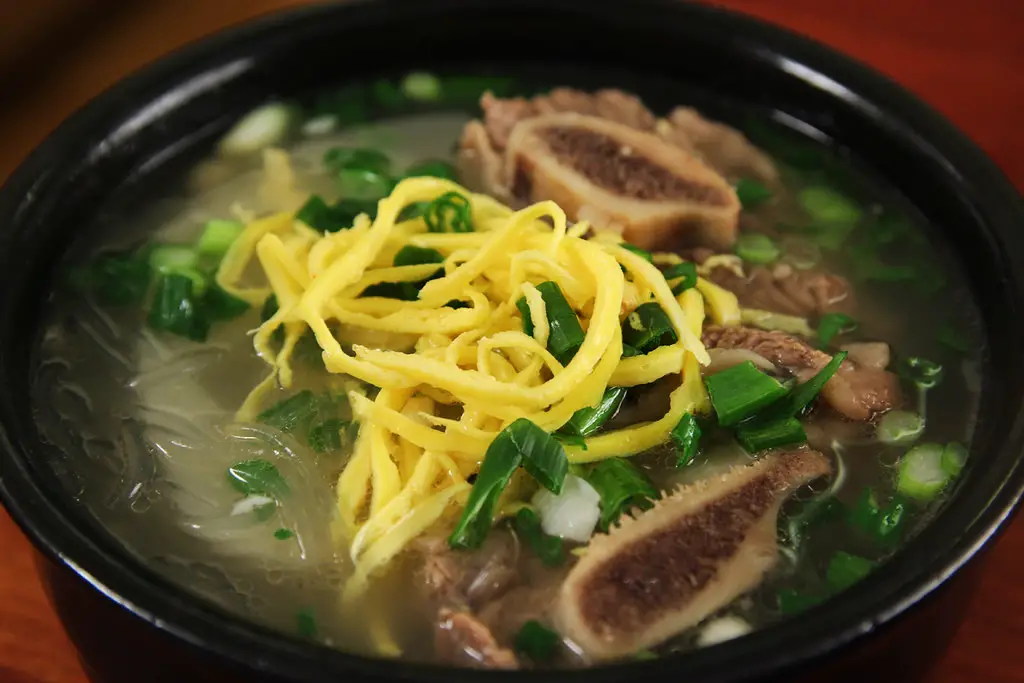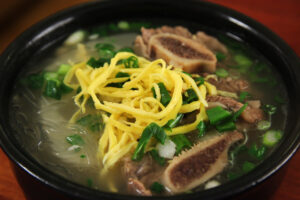Galbitang, or Korean beef short rib soup, is a hearty and nourishing dish that’s perfect for colder days or when you’re in need of comfort food. This traditional soup features tender beef short ribs, clear broth, and a medley of vegetables and seasonings. Here’s how you can make it at home.
Ingredients:
2 pounds of beef short ribs
1 large onion, peeled and quartered
2 cloves of garlic, crushed
2 green onions, chopped (white and green parts separated)
1 small carrot, cut into rounds
1 small daikon radish, cut into chunks
1 tablespoon soy sauce
1 teaspoon sesame oil
Salt and pepper to taste
Instructions:
Prepare the Beef Short Ribs:
Rinse the short ribs under cold water to remove excess blood and bone fragments.
Place the ribs in a large pot of cold water. Bring to a boil and simmer for about 10 minutes to blanch the meat and remove impurities.
Drain the water and rinse the ribs again to remove any residual scum or impurities.
Simmer the Broth:
In a clean pot, add the rinsed short ribs, onion, garlic, and white parts of the green onions.
Fill the pot with enough water to cover the ingredients. Bring to a boil, then reduce the heat to a gentle simmer.
Simmer the broth for at least 1.5 to 2 hours, allowing the flavors to develop. Skim off any foam or excess fat that rises to the surface.
Add Vegetables and Seasoning:
After the broth has simmered, remove the onion and garlic. Add the carrot and daikon radish to the pot, and simmer for an additional 30 minutes, or until the vegetables are tender.
Stir in the soy sauce, sesame oil, and season with salt and pepper to taste.
Adjust the seasoning as needed, adding more soy sauce or salt if desired.
Serve the Galbitang:
Ladle the soup into bowls, ensuring each serving has a generous amount of beef and vegetables.
Garnish with the green parts of the chopped green onions.
Serve the soup hot, accompanied by a bowl of steamed rice and kimchi for a complete Korean meal.
Tips for Success:
Ribs Selection: Choose beef short ribs with a good balance of meat and fat for a richer flavor.
Cooking Time: Simmering the broth slowly for at least 2 hours ensures the meat becomes tender and the broth develops a deep, savory taste.
Additional Flavor: For a more intense flavor, you can add a dried shiitake mushroom or a piece of kombu (dried kelp) during the simmering process.
Galbitang is a beloved dish in Korean cuisine, known for its simplicity and rich flavors.
Making this soup at home allows you to enjoy its comforting qualities and customize the ingredients to your taste.
Variations and Additions:
Noodles: Some people enjoy adding glass noodles (dangmyeon) to their galbitang for added texture. If you choose to include them, soak the noodles in warm water for about 10 minutes, then add them to the soup during the last 5-10 minutes of cooking.
Mushrooms: Besides dried shiitake, fresh mushrooms like enoki or button mushrooms can add extra flavor and texture.
Seasonings: In addition to soy sauce, some cooks like to add a splash of rice wine or mirin to enhance the soup’s umami profile.
Spices: For those who like a bit of heat, adding a touch of red pepper flakes or gochugaru (Korean chili powder) can bring a gentle warmth to the dish.
Herbs: While green onions are traditional, you can also experiment with cilantro or parsley as a garnish for a fresh burst of flavor.
Storage and Reheating:
Galbitang can be stored in the refrigerator for 3-4 days or in the freezer for up to 2-3 months.
When reheating, be sure to bring the soup to a full boil to ensure it’s properly heated through.
If you’ve added glass noodles, they might absorb more liquid as they sit, so you may need to add a bit of water or broth when reheating.
Serving Suggestions:
Traditional Sides: Galbitang pairs well with traditional Korean banchan, such as kimchi, pickled radish, or seasoned spinach. These sides provide a balance of flavors and textures.
Rice: White rice is the classic accompaniment to galbitang. For a healthier option, consider brown rice or mixed grain rice (japgokbap).
Garnishes: Besides green onions, toasted sesame seeds can add a nutty flavor, while julienned red chili peppers offer a pop of color.
With these tips and variations, you can create a personalized galbitang that suits your preferences while maintaining the essence of this comforting Korean dish. Whether you’re enjoying it on a cold day or sharing it with family and friends, galbitang is sure to warm both hearts and stomachs.




